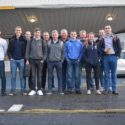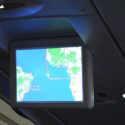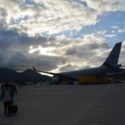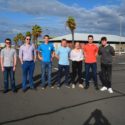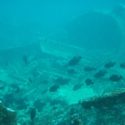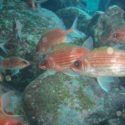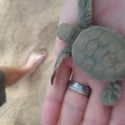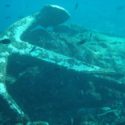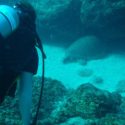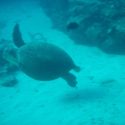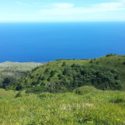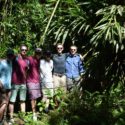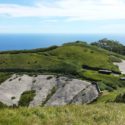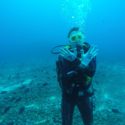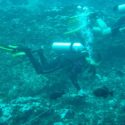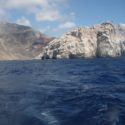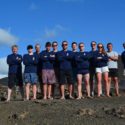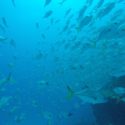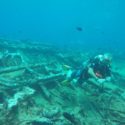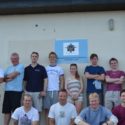After a slight false start with Off Cdt Moss having arrived a day early, kit prep took place at RAF Wittering. Expedition members were issued regulators, BCDs, masks, wetsuits, dive knives, fins, dive computers and grot bags. We met our four instructors Kev Jones, Mark ‘Misty’ Istance, Jim Metcalf and Sam Goodwin at RAF Brize Norton. The team completed their Ocean Diver theory exams and headed off to the airport café. After a team photograph, it was time to board what would certainly be the longest domestic flight any of us had done.
We stepped off the aircraft into very un-March-UK weather. What we’d lost in degrees latitude felt more than made up for in degrees Celsius.
Having each had one day of daylight savings time in the UK before leaving, we put our clocks back to GMT – our local time for the next two weeks. After being briefed in the aircraft terminal on the importance of the mandatory Asi policy of waving to a passing vehicles, we collected the two land rovers, loaded them up with our bags and headed to our accommodation, waving at anything else that was moving along the way.
Our accommodation was basic but proved effective at sheltering us from the Asi elements of mosquitos and land crabs over following fortnight. Girls and OCs got their own rooms, resulting in much higher room utilisation further down the block.
That afternoon, we did a shakedown dive in English Bay to check our kit was functioning correctly and a U/S dive knife clip was discovered by OC Moss when his knife failed to return from the dive with him.
Day 2 saw our first boat dives. The first dive of the day was the wreck of the Derby. A steel steam trawler, she was used from 1923 until she sank at her moorings in heavy seas in 1929 by the English Bay Company to transport guano from Boatswain Bird Island. The most prominent feature of this shallow (~5m) wreck is her boiler, and it was here that we got to see first-hand how ‘wrecked’ Asi wrecks are. As Misty put it, because the seas around Ascension can be so rough, “you’re never going to find an intact Spanish Galleon with all her sails up” on the sea floor. All the wrecks we saw were pretty bashed flat.
The second dive of the day was at ‘Triangles’. This was particularly exhilarating as we experienced our first no-clear-surface dive (cave dives to the uninitiated).
The Ocean Diver open water training got well under way on day 3 with out-of-air drills being practiced. Everyone had to be able to retrieve their buddy’s alternate supply and make a controlled ascent. This was done at our first dive site of Red Rock.
The cave diving got even better on the day’s second dive at Eddie’s Gullies. These caves were much narrower, darker and longer. One of the swim-through tunnels had a rope through it to guide anxious divers and contained vast numbers of squirrel fish. Enormous crayfish were also spotted in these caves. The under-training sports divers practiced controlled buoyant lifts and towing a casualty.
The highlight of the day was turtle watching, when we watched the sun set on Long Beach near Georgetown, and watched enormous female Green turtles haul themselves up the beach to dig their nests and lay their eggs. We also helped a newly hatched baby turtle reach the sea where it surely became something’s late evening meal.
Day 4 saw the completion of the ocean diver’s open water syllabus with each diver leading a dive, practicing the ‘rule of thirds’; that is a using a third of the air on the swim out and using a third back to surface with a third.
The first dive of the day was at the wreck of the Soudan and Tortoise. Soudan makes up the majority of the steel at this wreck site. A large ship of over 80m, she was built in 1885 for the Eastern Shipping Company and bound for Antwerp from Tacoma with a cargo of grain when she was wrecked early in the morning on 5th February 1892. The crew were all saved. We also managed to spot her mast located some distance away in a gully. Tortoise is thought to be on the same site but because of her smaller size and teak construction, much less of her remains. She was built in 1805 as a stores’ ship for the East India Company and originally named Sir Edward Hughes but after being presented to the Admiralty in 1806, she was given her final name of Tortoise. From 1845 she served as a stores’ ship at Ascension until she was deliberately sunk in 1859.
The second dive of the day was at dive site White Rock. There was an abundance of marine life here and more caves and swim-throughs. The name of the site comes from the nearby large rock which has a great number of sea birds nesting on it. Because of the introduction of rats and cats to the Ascension mainland, no seabirds are to be found there. Despite being just meters away, the precious few meters of water separating White Rock from the mainland are enough to protect the nesting birds, which over the years have turned the rock white.
Every four days we had a 24hr break from diving and White rock was our last dive for 24hrs. That afternoon Kev took us up to the Ascension summit, Green Mountain.
The 2700ft-high peak has an incredible variety of plant life, much of which was planted from seeds and saplings taken from Kew Gardens in London. It is now the largest artificial forest in the world and has the only natural water source on the island, the dew pond.
Much of the history of the settlement of Ascension Island seems to be one dominated with trying to get water. The original place of the Marine Barracks is on Green Mountain for this reason. The view from the summit was non-existent, but on the climb up were spectacular.
The first dive of the day took place in Kettle Cove which included a spectacular wall dive. In the evening, we did our first night dive off Guano Jetty in English Bay and discovered how feeble our torches were. The hundreds of Black Sturgeon fish that usually dominated the fish life during the day littered the bottom wedged into rocks in their strange open-eyed sleep.
Dive sites Pyramid Point and Stella’s were visited on Day 6. The UT sports divers practiced putting up delayed surface marker buoys. Several dysfunctional, partially-inflated DSMBs were released before the canvas tubes belonging to Off Cdts Moss and Baker and APO Ogden were consistently penetrating the surface potent and erect.
Lion’s Mane and Eddie’s Gullies were visited on day 7. Sports diver training continued with distance line practice and further controlled buoyant lifts with rescue breaths.
The two dives at Boatswain Bird Island that occurred on day 8 were probably the best two of the trip. Because the island was not connected to the mainland, the birdlife was incredible. Swimming with sharks, spectacular shear wall dives, black sturgeon feeding frenzies in one of the most remote parts of one of the most remote island in the world was pretty special.
On the way there we passed the Ariane Space Tracking Facility and saw a perspective of Ascension that few other than a handful of conservationists and yachtsmen ever get.
After another all-too brief lie-in provided by our mandatory 24hr rest from diving, in the afternoon we visited One Hook dive site – the former Asi rubbish dump. It turned out to be a highly enjoyable dive with time spent temporarily refloating old glass bottles, and trying to grab slippery eels.
In the evening we did our second and last night dive of the expedition, again from Guano Jetty, English Bay. The sea fleas were out in force and many of us experienced itchy heads from microscopic stings.
Clarence Bay Arches dive site was visited in the morning of day 10. This was a sports diver progression dive to 25m max depth. There were many turtles in the area. In the afternoon, we returned to the Soudan and Tortoise.
Another sports diver depth progression dive, this time to 30m off China Wreck. This wreck is one of Ascension’s more mysterious, as the identity of this iron sailing vessel lying 18 metres of water is unknown. Remains of iron girders, steel plates, steam winches and anchors are present as well as Ch’Ing Dynasty porcelain plates that appear to have been her cargo. The Ch’Ing Dynasty lasted from 1644 to 1912 and as the ship seems to be fairly modern the wreck is guessed to be from around c1920.
For our final dive on Ascension, we went to the Yorkshire Chariots dive sight, named after the regiment expedition that discovered the odd vehicle chassis in 2012. Because of the location off from Long Beach, there were a great many turtles to be seen by the first wave of divers in the water.
Our final day on Ascension was spent tidying up the exped centre, and washing down the vehicles.
Ex. Ascension Endeavour was an incredible truly once-in-a-lifetime experience for us and one we’ll never forget.
The aims of the expedition were:
a. To develop individual courage and leadership skills through controlled exposure to risk in a challenging outdoor environment in order to enhance operational capability.
b. To promote leadership skills and foster team spirit in a challenging and adventurous environment.
c. To train qualified divers as Ocean Divers or Sports Divers depending on previous experience and qualifications.
d. To carry out world class diving in a unique, challenging and remote environment.
e. Build experience and further develop divers’ knowledge, skills and proficiency in dive planning, organization and management.
f. Explore effective communication skills and models theoretically on land before being observed in the pressurized situation of underwater conditions.
All Expedition aims were exceeded.
B MOSS
Officer Cadet
Cambridge University Air Squadron


